小学英语五大时态
- 格式:doc
- 大小:40.50 KB
- 文档页数:3
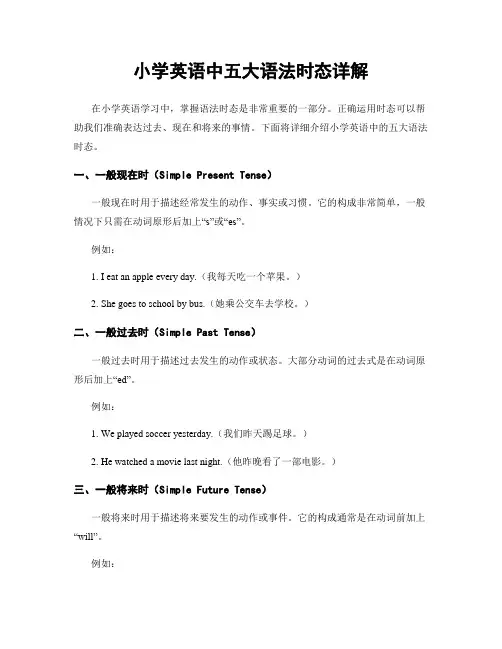
小学英语中五大语法时态详解在小学英语学习中,掌握语法时态是非常重要的一部分。
正确运用时态可以帮助我们准确表达过去、现在和将来的事情。
下面将详细介绍小学英语中的五大语法时态。
一、一般现在时(Simple Present Tense)一般现在时用于描述经常发生的动作、事实或习惯。
它的构成非常简单,一般情况下只需在动词原形后加上“s”或“es”。
例如:1. I eat an apple every day.(我每天吃一个苹果。
)2. She goes to school by bus.(她乘公交车去学校。
)二、一般过去时(Simple Past Tense)一般过去时用于描述过去发生的动作或状态。
大部分动词的过去式是在动词原形后加上“ed”。
例如:1. We played soccer yesterday.(我们昨天踢足球。
)2. He watched a movie last night.(他昨晚看了一部电影。
)三、一般将来时(Simple Future Tense)一般将来时用于描述将来要发生的动作或事件。
它的构成通常是在动词前加上“will”。
例如:1. I will visit my grandparents next week.(下周我将去拜访我的祖父母。
)2. She will learn to play the piano in the future.(她将来会学弹钢琴。
)四、现在进行时(Present Continuous Tense)现在进行时用于描述正在进行的动作。
它的构成是“be动词+动词的现在分词”。
例如:1. They are playing basketball in the park.(他们正在公园里打篮球。
)2. I am studying for the exam.(我正在备考考试。
)五、过去进行时(Past Continuous Tense)过去进行时用于描述过去某个时间正在进行的动作。
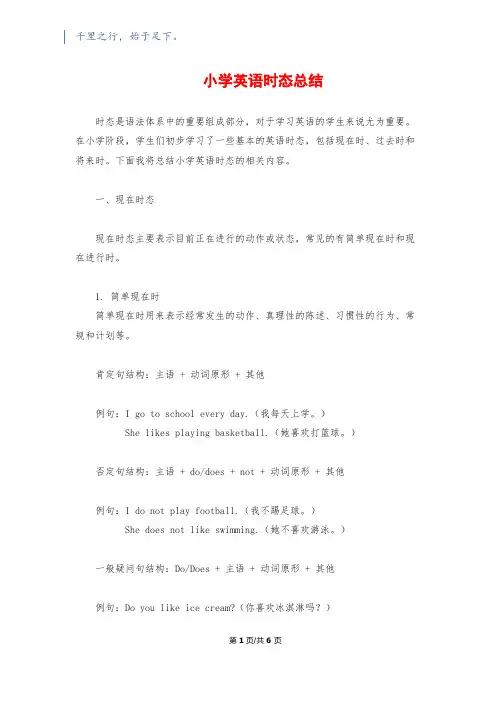
小学英语时态总结时态是语法体系中的重要组成部分,对于学习英语的学生来说尤为重要。
在小学阶段,学生们初步学习了一些基本的英语时态,包括现在时、过去时和将来时。
下面我将总结小学英语时态的相关内容。
一、现在时态现在时态主要表示目前正在进行的动作或状态,常见的有简单现在时和现在进行时。
1. 简单现在时简单现在时用来表示经常发生的动作、真理性的陈述、习惯性的行为、常规和计划等。
肯定句结构:主语 + 动词原形 + 其他例句:I go to school every day.(我每天上学。
)She likes playing basketball.(她喜欢打篮球。
)否定句结构:主语 + do/does + not + 动词原形 + 其他例句:I do not play football.(我不踢足球。
)She does not like swimming.(她不喜欢游泳。
)一般疑问句结构:Do/Does + 主语 + 动词原形 + 其他例句:Do you like ice cream?(你喜欢冰淇淋吗?)第1页/共6页Does he go to the park?(他去公园吗?)2. 现在进行时现在进行时表示目前正在进行的动作。
肯定句结构:主语 + am/is/are + 动词-ing + 其他例句:I am watching TV now.(我正在看电视。
)They are playing soccer.(他们正在踢足球。
)否定句结构:主语 + am/is/are + not + 动词-ing + 其他例句:I am not reading a book.(我没有在读书。
)She is not studying.(她没有在学习。
)一般疑问句结构:Am/Is/Are + 主语 + 动词-ing + 其他例句:Are you eating lunch?(你在吃午饭吗?)Is he playing the piano?(他在弹钢琴吗?)二、过去时态过去时态主要表示过去发生的动作或状态,常见的有简单过去时和过去进行时。

英语的五大时态包括现在时、过去时、将来时、现在完成时和过去完成时。
以下是这五大时态的句子结构:
1. 现在时:主语 + 动词 + 其他成分。
例如:I eat an apple every day.(我每天吃一个苹果。
)
2. 过去时:主语 + 动词的过去式 + 其他成分。
例如:She walked to the park yesterday.(她昨天走到公园。
)
3. 将来时:主语 + will + 动词原形 + 其他成分。
例如:He will go to school tomorrow.(他明天将会去上学。
)
4. 现在完成时:主语 + have/has + 动词的过去分词 + 其他成分。
例如:I have finished my homework.(我已经完成了我的作业。
)
5. 过去完成时:主语 + had + 动词的过去分词 + 其他成分。
例如:She had eaten her dinner before coming to the party.(她在来参加聚会之前已经吃过晚饭了。
)
需要注意的是,五大时态的句子结构并不是固定不变的,它们会根据语境和表达的需要而有所变化。
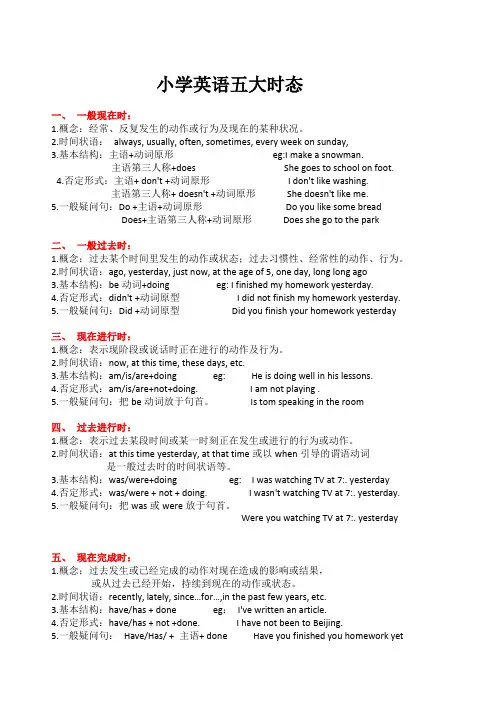
小学英语五大时态一、一般现在时:1.概念:经常、反复发生的动作或行为及现在的某种状况。
2.时间状语:always, usually, often, sometimes, every week on sunday,3.基本结构:主语+动词原形eg:I make a snowman.主语第三人称+does She goes to school on foot. 4.否定形式:主语+ don't +动词原形I don't like washing.主语第三人称+ doesn't +动词原形She doesn't like me.5.一般疑问句:Do +主语+动词原形Do you like some breadDoes+主语第三人称+动词原形Does she go to the park二、一般过去时:1.概念:过去某个时间里发生的动作或状态;过去习惯性、经常性的动作、行为。
2.时间状语:ago, yesterday, just now, at the age of 5, one day, long long ago3.基本结构:be动词+doing eg: I finished my homework yesterday.4.否定形式:didn't +动词原型I did not finish my homework yesterday.5.一般疑问句:Did +动词原型Did you finish your homework yesterday三、现在进行时:1.概念:表示现阶段或说话时正在进行的动作及行为。
2.时间状语:now, at this time, these days, etc.3.基本结构:am/is/are+doing eg: He is doing well in his lessons.4.否定形式:am/is/are+not+doing. I am not playing .5.一般疑问句:把be动词放于句首。

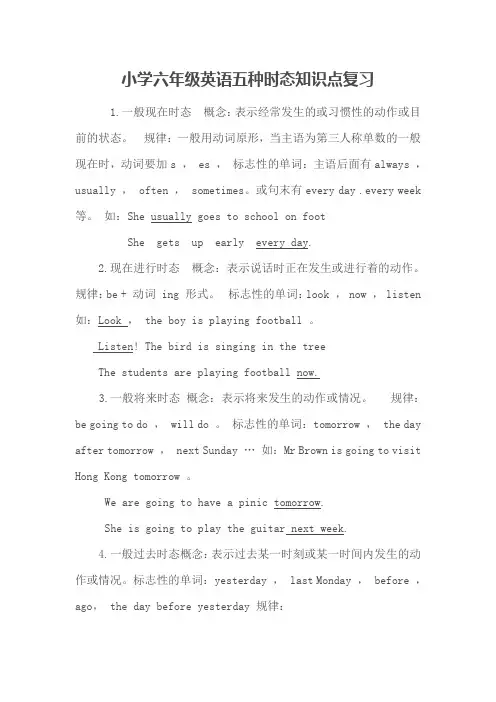
小学六年级英语五种时态知识点复习1.一般现在时态概念:表示经常发生的或习惯性的动作或目前的状态。
规律:一般用动词原形,当主语为第三人称单数的一般现在时,动词要加s , es ,标志性的单词:主语后面有always ,usually , often , sometimes。
或句末有every day .every week 等。
如:She usually goes to school on footShe gets up early every day.2.现在进行时态概念:表示说话时正在发生或进行着的动作。
规律:be + 动词 ing 形式。
标志性的单词:look , now , listen 如:Look , the boy is playing football 。
Listen! The bird is singing in the treeThe students are playing football now.3.一般将来时态概念:表示将来发生的动作或情况。
规律:be going to do , will do 。
标志性的单词:tomorrow , the day after tomorrow , next Sunday …如:Mr Brown is going to visit Hong Kong tomorrow 。
We are going to have a pinic tomorrow.She is going to play the guitar next week.4.一般过去时态概念:表示过去某一时刻或某一时间内发生的动作或情况。
标志性的单词:yesterday , last Monday , before ,ago, the day before yesterday 规律:(1)一般情况动词后面加ed ; 如:worked , cleaned ,washed ,(2)以不发音e结尾的动词加d就要以了; 如:lived , moved ,loved(3)以辅音加y结尾的动词把y改成i再加ed ; 如:study–studied , carry—carried(4)重读闭音节的动词要双写末尾的辅音字母再加ed; 如:stop —stopped shop—shopped skip--- skipped(5)特殊变化:见不规则动词表。
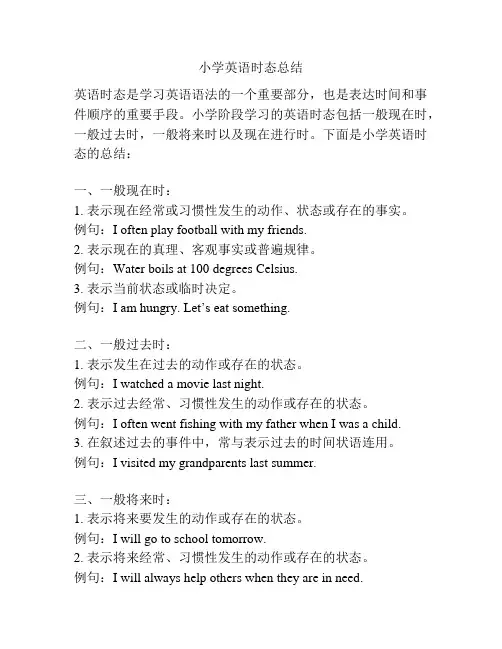
小学英语时态总结英语时态是学习英语语法的一个重要部分,也是表达时间和事件顺序的重要手段。
小学阶段学习的英语时态包括一般现在时,一般过去时,一般将来时以及现在进行时。
下面是小学英语时态的总结:一、一般现在时:1. 表示现在经常或习惯性发生的动作、状态或存在的事实。
例句:I often play football with my friends.2. 表示现在的真理、客观事实或普遍规律。
例句:Water boils at 100 degrees Celsius.3. 表示当前状态或临时决定。
例句:I am hungry. Let’s eat something.二、一般过去时:1. 表示发生在过去的动作或存在的状态。
例句:I watched a movie last night.2. 表示过去经常、习惯性发生的动作或存在的状态。
例句:I often went fishing with my father when I was a child.3. 在叙述过去的事件中,常与表示过去的时间状语连用。
例句:I visited my grandparents last summer.三、一般将来时:1. 表示将来要发生的动作或存在的状态。
例句:I will go to school tomorrow.2. 表示将来经常、习惯性发生的动作或存在的状态。
例句:I will always help others when they are in need.3. 在表示将来的时间状语后,可以用一般现在时代替一般将来时。
例句:I am going to the park this afternoon.四、现在进行时:1. 表示现在正在进行的动作。
例句:I am reading a book at the moment.2. 表示计划或安排好的未来动作或行程。
例句:I am going to the supermarket this afternoon.3. 用于表示临时状态或权宜之计。
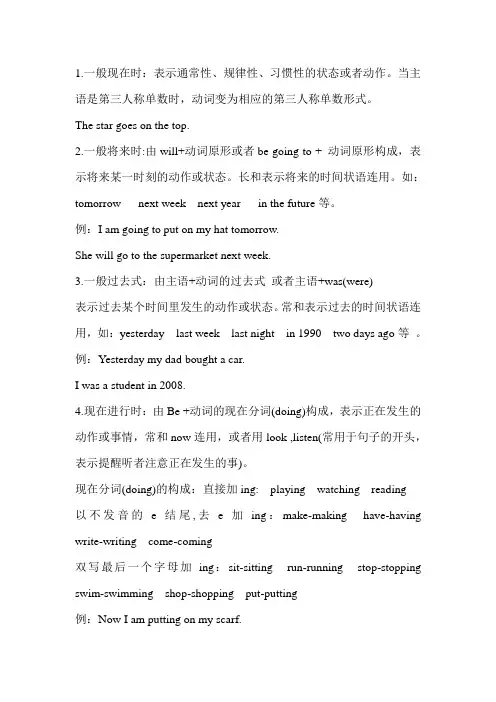
1.一般现在时:表示通常性、规律性、习惯性的状态或者动作。
当主语是第三人称单数时,动词变为相应的第三人称单数形式。
The star goes on the top.2.一般将来时:由will+动词原形或者be going to + 动词原形构成,表示将来某一时刻的动作或状态。
长和表示将来的时间状语连用。
如:tomorrow next week next year in the future等。
例:I am going to put on my hat tomorrow.She will go to the supermarket next week.3.一般过去式:由主语+动词的过去式或者主语+was(were)表示过去某个时间里发生的动作或状态。
常和表示过去的时间状语连用,如:yesterday last week last night in 1990 two days ago等。
例:Yesterday my dad bought a car.I was a student in 2008.4.现在进行时:由Be +动词的现在分词(doing)构成,表示正在发生的动作或事情,常和now连用,或者用look ,listen(常用于句子的开头,表示提醒听者注意正在发生的事)。
现在分词(doing)的构成:直接加ing: playing watching reading以不发音的e结尾,去e加ing:make-making have-having write-writing come-coming双写最后一个字母加ing:sit-sitting run-running stop-stopping swim-swimming shop-shopping put-putting例:Now I am putting on my scarf.。
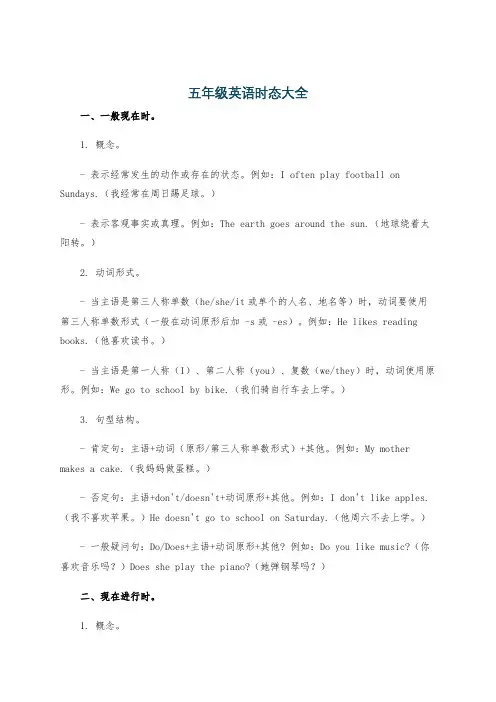
五年级英语时态大全一、一般现在时。
1. 概念。
- 表示经常发生的动作或存在的状态。
例如:I often play football on Sundays.(我经常在周日踢足球。
)- 表示客观事实或真理。
例如:The earth goes around the sun.(地球绕着太阳转。
)2. 动词形式。
- 当主语是第三人称单数(he/she/it或单个的人名、地名等)时,动词要使用第三人称单数形式(一般在动词原形后加 -s或 -es)。
例如:He likes reading books.(他喜欢读书。
)- 当主语是第一人称(I)、第二人称(you)、复数(we/they)时,动词使用原形。
例如:We go to school by bike.(我们骑自行车去上学。
)3. 句型结构。
- 肯定句:主语+动词(原形/第三人称单数形式)+其他。
例如:My mother makes a cake.(我妈妈做蛋糕。
)- 否定句:主语+don't/doesn't+动词原形+其他。
例如:I don't like apples.(我不喜欢苹果。
)He doesn't go to school on Saturday.(他周六不去上学。
)- 一般疑问句:Do/Does+主语+动词原形+其他? 例如:Do you like music?(你喜欢音乐吗?)Does she play the piano?(她弹钢琴吗?)二、现在进行时。
1. 概念。
- 表示现在正在进行的动作或存在的状态。
例如:Look! The boy is running.(看!那个男孩正在跑步。
)2. 动词形式。
- 动词be(am/is/are)+动词的 -ing形式。
例如:I am reading a book.(我正在读一本书。
)They are playing games.(他们正在玩游戏。
)3. 句型结构。
- 肯定句:主语+be(am/is/are)+动词 -ing形式+其他。
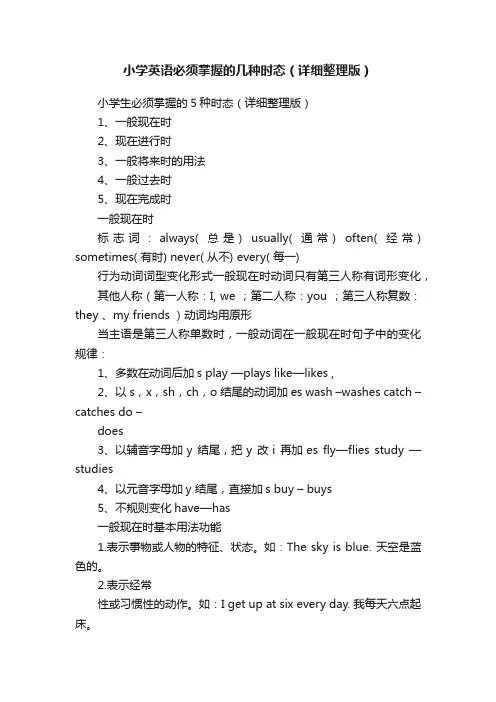
小学英语必须掌握的几种时态(详细整理版)小学生必须掌握的5种时态(详细整理版)1、一般现在时2、现在进行时3、一般将来时的用法4、一般过去时5、现在完成时一般现在时标志词:always( 总是) usually( 通常) often( 经常) sometimes( 有时) never( 从不) every( 每一)行为动词词型变化形式一般现在时动词只有第三人称有词形变化,其他人称(第一人称:I, we ;第二人称:you ;第三人称复数:they 、my friends )动词均用原形当主语是第三人称单数时,一般动词在一般现在时句子中的变化规律:1、多数在动词后加s play —plays like—likes ,2、以s,x,sh,ch,o 结尾的动词加es wash –washes catch –catches do –does3、以辅音字母加y 结尾,把y 改i 再加es fly—flies study —studies4、以元音字母加y 结尾,直接加s buy – buys5、不规则变化have—has一般现在时基本用法功能1.表示事物或人物的特征、状态。
如:The sky is blue. 天空是蓝色的。
2.表示经常性或习惯性的动作。
如:I get up at six every day. 我每天六点起床。
3.表示客观现实。
如:The earth goes around the sun. 地球绕着太阳转。
The earth is round.构成1. be 动词:主语+be(am,is,are)+ 其它。
如:I am a boy. 我是一个男孩。
2.行为动词:主语+行为动词(+ 其它)。
如:We study English. 我们学习英语。
句型肯定句:A.be 动词:主语+ be + 其它成分H e is a worker.B.行为动词:主语+动词(注意人称变化) + 其它成分We like the little cat. 否定句:A.be 动词:主语+ be + not + 其它成分They are not students.B.行为动词:主语+助动词(do/does) + not + 动词原形+其它成分We don’t like the little cat.一般疑问句:A.be 动词:Am / Is /Are + 主语+ 其它成分Are you a teacher? Yes, I am. / No, I am not.Are they students of your school.Yes they are /No they aren,t.B.行为动词:助动词(Do/Does)+ 主语+动词原形+ 其它成分Do you like it? Yes, I do. / No. I don ’t . Doeshe(she) like it? Yes, he( she )does. / No,he ( she )doesn ’t.特殊疑问句:疑问词+ 一般疑问句A.be 动词:How many students are there in your school?B.行为动词:What do you usually do on Sunday?一般现在时动词be 和have 的变化形式1.动词Be 叫连系动词, 用法:第一人称单数用am ,第三人称单数用is,其它人称用are。
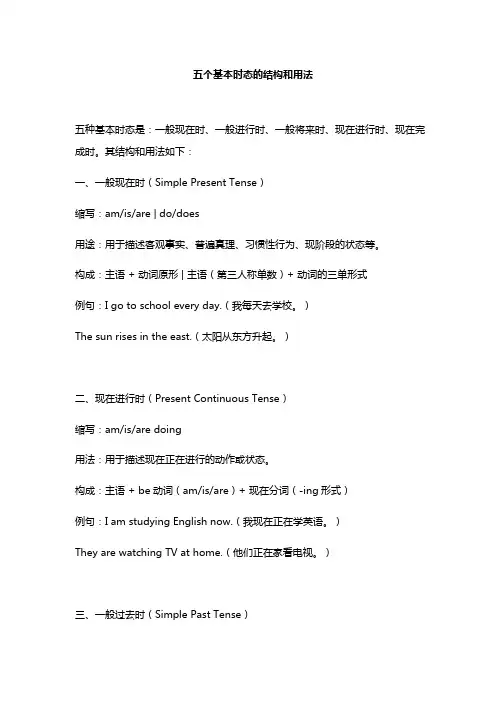
五个基本时态的结构和用法五种基本时态是:一般现在时、一般进行时、一般将来时、现在进行时、现在完成时。
其结构和用法如下:一、一般现在时(Simple Present Tense)缩写:am/is/are | do/does用途:用于描述客观事实、普遍真理、习惯性行为、现阶段的状态等。
构成:主语 + 动词原形 | 主语(第三人称单数)+ 动词的三单形式例句:I go to school every day.(我每天去学校。
)The sun rises in the east.(太阳从东方升起。
)二、现在进行时(Present Continuous Tense)缩写:am/is/are doing用法:用于描述现在正在进行的动作或状态。
构成:主语 + be动词(am/is/are)+ 现在分词(-ing形式)例句:I am studying English now.(我现在正在学英语。
)They are watching TV at home.(他们正在家看电视。
)三、一般过去时(Simple Past Tense)缩写:was/were | did用法:用于描述过去发生的动作或状态,强调的是过去发生,而现在不再发生的事。
构成:主语 + 动词过去式例句:I went to the cinema yesterday.(昨天我去了电影院。
)They played basketball last weekend.(他们上周末打了篮球。
)四、将来时(Simple Future Tense)缩写:will do/will be/be going to do/be going to be用法:用于描述将来要发生的动作或状态。
构成:主语 + will/shall + 动词原形例句:I will visit my grandparents next week.(我下周会去看望我的祖父母。
)She is going to start her new job next month.(她下个月开始新工作。
小学英语五种时态一、一般现在时:1.概念:(1)经常、反复发生的动作或行为及现在的某种状况。
(2)客观真理,客观存在,科学事实2.时间状语:always, usually, often, sometimes, every week (day, year, mont h…), once a week, on Sundays,3.基本结构:主语+be(am/is/are)/动原(主语为第三人称单数或不可数名词时,动词上要加(e)s )4.否定形式:主语+am/is/are+not;主语+don't /doesn't +动原(前面有助动词do,does时,要把动词还原)5.一般疑问句:be (am/is/are)+主语do /does +主语+动原(前面有助动词do,does时,要把动词还原)6.例句:. It seldom snows here. 这里很少下雪。
Water gets clean .水变清澈了He is always ready to help others. 他总是乐于助人。
Action speaks louder than words.事实胜于雄辩。
The moon move round the earth。
月亮绕着地球转。
二、一般过去时:1.概念:①过去某个时间里发生的动作或状态;②过去习惯性、经常性的动作、行为。
2.时间状语:ago, yesterday, the day before yesterday(前天), last week(year, night, month…), in 1989, just now, at the age of 5,one day, long long ago, once upon a time, etc.3.基本结构:①主语+ was/were ②主语+动词过去式(v-ed)4.否定形式:①主语+ was/were+not ②主语+didn't+动原5.一般疑问句:①Was/Were+主语…②Did+主语+动原…6.例句:She often came to help us in those days. (过去一段时间内)I didn't know you were so busy. (过去某个时间点)三、一般将来时:1. 概念:表示将要发生的动作或存在的状态及打算、计划或准备做某事。
小学英语时态总结英语时态是英语语法中的重要部分,它表示动作或状态发生的时间。
英语中常见的时态有简单现在时、现在进行时、一般过去时、过去进行时、将来时等。
下面是对小学英语时态的总结:一、简单现在时:动词的一般现在时表示经常性的、习惯性的行为或客观真理。
结构:主语 + 动词原形(第三人称单数加-s)例如:1. I go to school every day.2. He often plays soccer after school.3. The sun rises in the east.特殊用法:1. 表示现在状态的动词:be动词(am, is, are)结构:主语 + am/is/are + 表示状态的名词/形容词/副词等例如:1. I am hungry.2. She is happy.3. They are running.2. 表示未来安排或计划的动词:动词原形 + 表示将来的时间状语结构:主语 + will + 动词原形 + 表示时间的状语例如:1. We will have a picnic next Sunday.2. He will go to the movies tonight.3. She will visit her grandparents tomorrow.二、现在进行时:动词的现在进行时表示正在进行的动作。
结构:主语 + be动词(am, is, are)+ 动词-ing例如:1. I am studying now.2. He is playing basketball.3. They are watching TV.特殊用法:1. 表示将来按计划或安排或打算进行的动作结构:主语 + be going to + 动词原形 + 表示时间的状语例如:1. I am going to have dinner with my friends tomorrow.2. They are going to visit the museum next week.3. We are going to watch a movie tonight.三、一般过去时:动词的一般过去时表示过去发生的动作或状态。
一、现在进行时: 表示正在进行的、发生的动作。
通常在句子中有以下的词:now, look, listen.句子的结构如下:be 动词(is am are)+动词ing动词的ing形式有如下方法:1. 在动词后直接加ing,如: go-going , wash-washing,fly—flying2. 以不发音字母e结尾,去掉e再加ing,如:drive—driving, ride—riding,skate-skating,make-making,have-having,write-writing,take-taking, dive-diving,dance-dancing,come-coming3.双写双写末尾字母,再加ing,如:swim- swimming, run—running,get—getting, put-putting, set-setting.填空:1. She is _____ (walk, walking) now.2. They are _____ (sitting, siting) on the chair.3. Cindy is _____ (watch, watching) TV.4. Look, Nick is _____ (coming, come).5. Listen, she is _____ (singing, sing).6. Look, the girl is _____ (run).7. My mother and my father are _____ (dance).根据汉语意思填空:1. 他们正在读书. They are _____ (read)books.2. 我在做作业. I am _____ (do) my homework.3. 我妈妈正在做饭. My mother is _____(cook).4. 他正在写信. He is _____ (write)a letter.填入be动词的适当形式1. He _____ drinking water.2. Children _____ playing in the playground.3. I _____ going to the supermarket.二、一般现在时:表示通常性、规律性、习惯性的状态或者动作(有时间规律发生的事件)的一种时间状态在一般现在时中,当主语是第三人称单数时,谓语动词要用第三人称单数形式,即常在动词原形后加-s或-es。
五大时态总结小学时态知识点归纳一、现在时态现在时态表示目前正在进行的动作或状态,或者表示客观事实、经常性动作等。
1. 简单现在时:表示经常性的、客观的或普遍的真实情况。
例如:I like ice cream.(我喜欢冰淇淋。
)2. 现在进行时:表示现在正在进行的动作。
例如:They are playing in the park.(他们正在公园里玩。
)二、过去时态过去时态表示过去发生的动作或状态,也可以用来描述叙述、故事等。
1. 简单过去时:表示过去某个时间发生的动作或存在的状态。
例如:She watched a movie last night.(昨晚她看了一部电影。
)2. 过去进行时:表示过去某个时间正在进行的动作。
例如:He was studying when the phone rang.(电话响时他正在学习。
)三、将来时态将来时态表示将要发生的动作或存在的状态。
1. 简单将来时:表示将来要发生的动作或存在的状态。
例如:We will visit the museum tomorrow.(我们明天要参观博物馆。
)2. 将来进行时:表示将来某个时间正在进行的动作。
例如:I will be studying at this time tomorrow.(明天这个时候我将在学习。
)四、现在完成时态现在完成时态表示过去发生的某个动作对现在造成的影响或所达到的状态。
1. 现在完成时:由“have/has + 过去分词”构成。
例如:They have finished their homework.(他们已经完成作业。
)五、过去完成时态过去完成时态表示过去某个时间或动作之前已经完成的动作。
1. 过去完成时:由“had + 过去分词”构成。
例如:She had already left when I arrived.(我到达时,她已经离开了。
)以上是五大时态的总结和小学时态知识点的归纳,掌握好这些时态,对于正确表达过去、现在和将来的动作和状态是非常重要的。
小学英语中五大语法时态详解英语是一门广泛使用的语言,掌握好英语语法对于学习英语至关重要。
在小学阶段,学生们开始接触英语语法的基础知识,其中最重要的就是时态。
时态决定了句子中动词的形式,能够让我们清楚地表达出动作发生的时间。
本文将详细介绍小学英语中的五大语法时态。
一、一般现在时(Simple Present)一般现在时用于表达经常性的动作或客观事实。
在句子中,一般现在时的动词形式不随主语的人称和数的变化而变化。
例如:1. I go to school every day.(我每天去上学。
)2. He likes to play football.(他喜欢踢足球。
)二、一般过去时(Simple Past)一般过去时用于表达过去发生的动作或状态。
在句子中,一般过去时的动词形式通常以-ed或-d结尾,但也有一些不规则动词需要特别记忆。
例如:1. We visited the museum yesterday.(我们昨天参观了博物馆。
)2. She danced beautifully at the party.(她在派对上跳得很漂亮。
)三、一般将来时(Simple Future)一般将来时用于表达将来要发生的动作或事件。
在句子中,一般将来时通常使用助动词will加上动词原形。
例如:1. They will have a picnic next weekend.(他们下周末要去野餐。
)2. I will call you later.(我一会儿给你打电话。
)四、现在进行时(Present Continuous)现在进行时用于表达正在进行的动作。
在句子中,现在进行时的动词形式由be 动词(am/is/are)加上动词的ing形式构成。
例如:1. We are watching a movie right now.(我们正在看电影。
)2. She is studying for the exam.(她正在备考。
小学英语五大时态
一、一般现在时:
1.概念:经常、反复发生的动作或行为及现在的某种状况。
2.时间状语:always, usually, often, sometimes, every week on sunday,
3.基本结构:主语+do eg:I make a snowman.
主语第三人称+does she goes to school on foot.
4.否定形式:主语+ don't +do I don't like washing.
主语第三人称+ doesn't +do She doesn't like me.
5.一般疑问句:Do +主语+do Do you like some bread?
Does+主语第三人称+do Does she go to the park?
二、一般过去时:
1.概念:过去某个时间里发生的动作或状态;过去习惯性、经常性的动作、行为。
2.时间状语:ago, yesterday, just now, at the age of 5, one day, long long ago
3.基本结构:be动词+doing eg: I finished my homework yesterday.
4.否定形式:didn't +动词原型I did not finish my homework yesterday.
5.一般疑问句:Did +动词原型Did you finish your homework yesterday?
三、现在进行时:
1.概念:表示现阶段或说话时正在进行的动作及行为。
2.时间状语:now, at this time, these days, etc.
3.基本结构:am/is/are+doing eg: He is doing well in his lessons.
4.否定形式:am/is/are+not+doing. I am not playing .
5.一般疑问句:把be动词放于句首。
Is tom speaking in the room?
四、过去进行时:
1.概念:表示过去某段时间或某一时刻正在发生或进行的行为或动作。
2.时间状语:at this time yesterday, at that time或以when引导的谓语动词
是一般过去时的时间状语等。
3.基本结构:was/were+doing eg: I was watching TV at 7:00a.m. yesterday
4.否定形式:was/were + not + doing. I wasn't watching TV at 7:00a.m. yesterday.
5.一般疑问句:把was或were放于句首。
Were you watching TV at 7:00a.m. yesterday?
五、现在完成时:
1.概念:过去发生或已经完成的动作对现在造成的影响或结果,
或从过去已经开始,持续到现在的动作或状态。
2.时间状语:recently, lately, since…for…,in the past few years, etc.
3.基本结构:have/has + done eg:I've written an article.
4.否定形式:have/has + not +done. I have not been to Beijing.
5.一般疑问句:Have/Has/ + 主语+ done Have you finished you homework yet?
六、过去完成时:
1.概念:以过去某个时间为标准,在此以前发生的动作或行为,或在过去某动作之前完成的行为,即“过去的过去”。
2.时间状语:before, by the end of last year(ter m, month…),etc.
3.基本结构:had + done.
eg:I had already finished my homework when I watched the TV.
4.否定形式:had + not + done.
I hadn't finished my homework yet when I watched the TV.
5.一般疑问句:had放于句首。
Had you finished your homework when you watched the TV.
七、一般将来时:
1.概念:表示将要发生的动作或存在的状态及打算、计划或准备做某事。
2.时间状语:tomorrow, next day(week, month, year…),soon,
3.基本结构:be going to do; will+do eg:It is going to rain.
4.否定形式:not going to do ; will not be;I will not be a doctor.
5.一般疑问句:be+主语+going to do will+主语+going to do
Eg: will you going to park tomorrow?
八、过去将来时:
1.概念:立足于过去某一时刻,从过去看将来,常用于宾语从句中。
2.时间状语:the next day(morning, year…),the following month(week…),etc.
3.基本结构:was/were/going to + do;would/should + do.
Eg:He said he would help me.
4.否定形式:was/were/not + going to + do; would/should + not + do.
He said he wouldn't help me.
5.一般疑问句:was或were放于句首;would/should 提到句首。
I didn't know whether he would help me.。